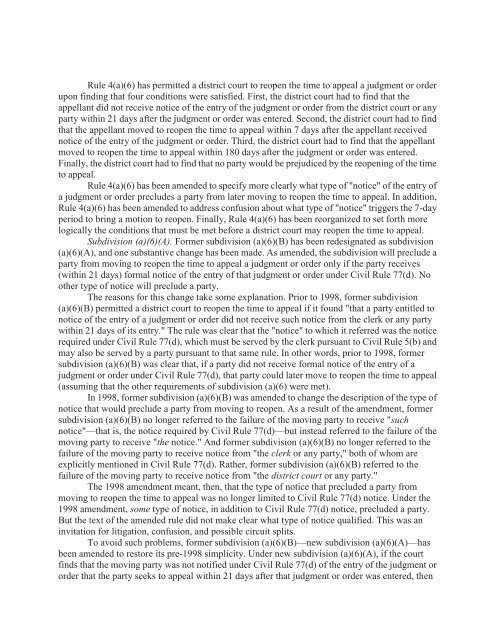Federal Rules of Appellate Procedure 2014-2015, 2014a
Federal Rules of Appellate Procedure 2014-2015, 2014a
Federal Rules of Appellate Procedure 2014-2015, 2014a
You also want an ePaper? Increase the reach of your titles
YUMPU automatically turns print PDFs into web optimized ePapers that Google loves.
Rule 4(a)(6) has permitted a district court to reopen the time to appeal a judgment or order<br />
upon finding that four conditions were satisfied. First, the district court had to find that the<br />
appellant did not receive notice <strong>of</strong> the entry <strong>of</strong> the judgment or order from the district court or any<br />
party within 21 days after the judgment or order was entered. Second, the district court had to find<br />
that the appellant moved to reopen the time to appeal within 7 days after the appellant received<br />
notice <strong>of</strong> the entry <strong>of</strong> the judgment or order. Third, the district court had to find that the appellant<br />
moved to reopen the time to appeal within 180 days after the judgment or order was entered.<br />
Finally, the district court had to find that no party would be prejudiced by the reopening <strong>of</strong> the time<br />
to appeal.<br />
Rule 4(a)(6) has been amended to specify more clearly what type <strong>of</strong> "notice" <strong>of</strong> the entry <strong>of</strong><br />
a judgment or order precludes a party from later moving to reopen the time to appeal. In addition,<br />
Rule 4(a)(6) has been amended to address confusion about what type <strong>of</strong> "notice" triggers the 7-day<br />
period to bring a motion to reopen. Finally, Rule 4(a)(6) has been reorganized to set forth more<br />
logically the conditions that must be met before a district court may reopen the time to appeal.<br />
Subdivision (a)(6)(A). Former subdivision (a)(6)(B) has been redesignated as subdivision<br />
(a)(6)(A), and one substantive change has been made. As amended, the subdivision will preclude a<br />
party from moving to reopen the time to appeal a judgment or order only if the party receives<br />
(within 21 days) formal notice <strong>of</strong> the entry <strong>of</strong> that judgment or order under Civil Rule 77(d). No<br />
other type <strong>of</strong> notice will preclude a party.<br />
The reasons for this change take some explanation. Prior to 1998, former subdivision<br />
(a)(6)(B) permitted a district court to reopen the time to appeal if it found "that a party entitled to<br />
notice <strong>of</strong> the entry <strong>of</strong> a judgment or order did not receive such notice from the clerk or any party<br />
within 21 days <strong>of</strong> its entry." The rule was clear that the "notice" to which it referred was the notice<br />
required under Civil Rule 77(d), which must be served by the clerk pursuant to Civil Rule 5(b) and<br />
may also be served by a party pursuant to that same rule. In other words, prior to 1998, former<br />
subdivision (a)(6)(B) was clear that, if a party did not receive formal notice <strong>of</strong> the entry <strong>of</strong> a<br />
judgment or order under Civil Rule 77(d), that party could later move to reopen the time to appeal<br />
(assuming that the other requirements <strong>of</strong> subdivision (a)(6) were met).<br />
In 1998, former subdivision (a)(6)(B) was amended to change the description <strong>of</strong> the type <strong>of</strong><br />
notice that would preclude a party from moving to reopen. As a result <strong>of</strong> the amendment, former<br />
subdivision (a)(6)(B) no longer referred to the failure <strong>of</strong> the moving party to receive "such<br />
notice"—that is, the notice required by Civil Rule 77(d)—but instead referred to the failure <strong>of</strong> the<br />
moving party to receive "the notice." And former subdivision (a)(6)(B) no longer referred to the<br />
failure <strong>of</strong> the moving party to receive notice from "the clerk or any party," both <strong>of</strong> whom are<br />
explicitly mentioned in Civil Rule 77(d). Rather, former subdivision (a)(6)(B) referred to the<br />
failure <strong>of</strong> the moving party to receive notice from "the district court or any party."<br />
The 1998 amendment meant, then, that the type <strong>of</strong> notice that precluded a party from<br />
moving to reopen the time to appeal was no longer limited to Civil Rule 77(d) notice. Under the<br />
1998 amendment, some type <strong>of</strong> notice, in addition to Civil Rule 77(d) notice, precluded a party.<br />
But the text <strong>of</strong> the amended rule did not make clear what type <strong>of</strong> notice qualified. This was an<br />
invitation for litigation, confusion, and possible circuit splits.<br />
To avoid such problems, former subdivision (a)(6)(B)—new subdivision (a)(6)(A)—has<br />
been amended to restore its pre-1998 simplicity. Under new subdivision (a)(6)(A), if the court<br />
finds that the moving party was not notified under Civil Rule 77(d) <strong>of</strong> the entry <strong>of</strong> the judgment or<br />
order that the party seeks to appeal within 21 days after that judgment or order was entered, then


















